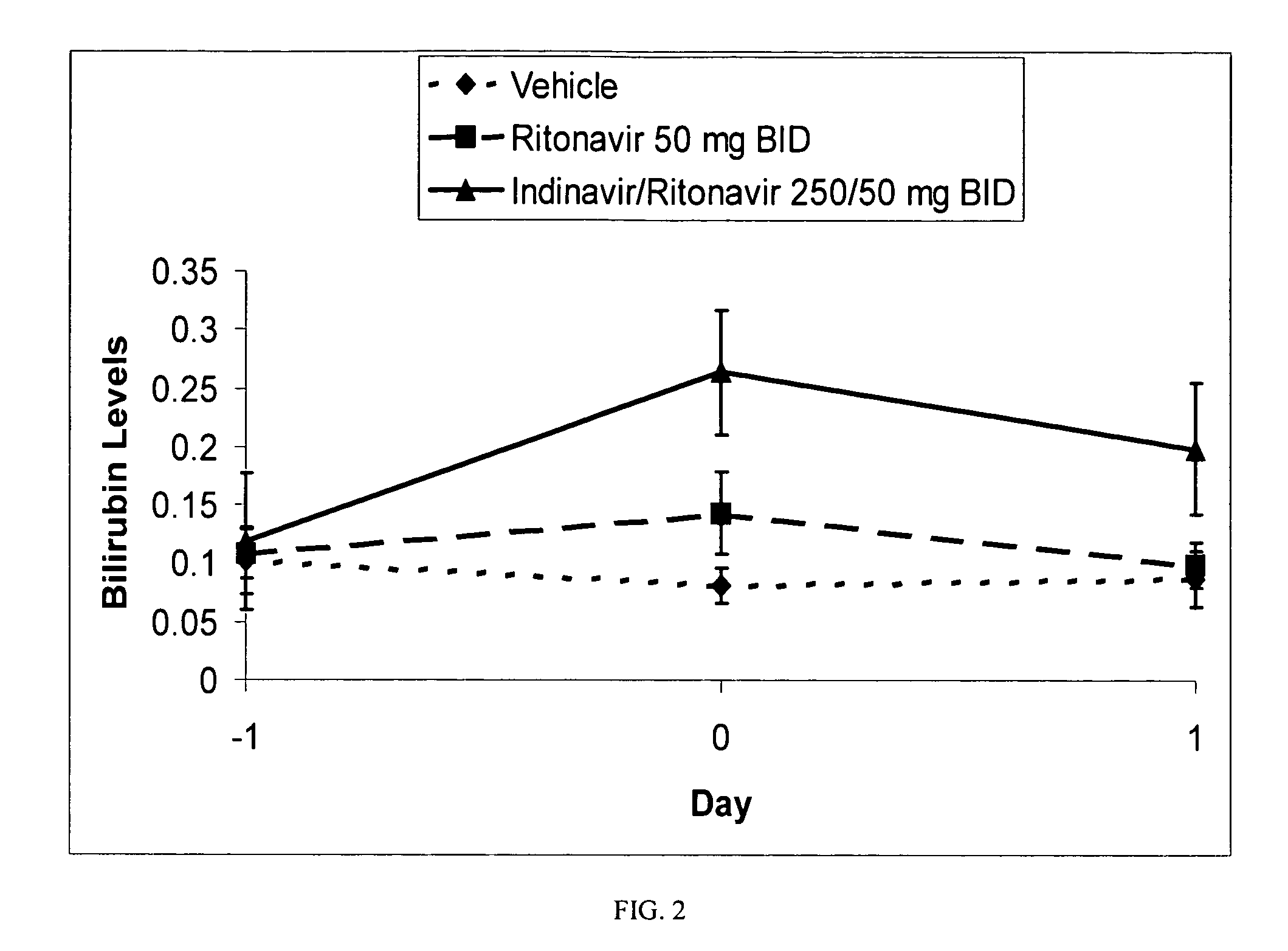Method for treating a disease, disorder or adverse effect caused by an elevated serum concentration of an ugtiai substrate
a technology of ugtiai and substrate, which is applied in the direction of drug composition, peptide/protein ingredients, extracellular fluid disorder, etc., can solve the problems of unconjugated hyperbilirubinemia and a 6-25% incidence of asymptomatic individuals
- Summary
- Abstract
- Description
- Claims
- Application Information
AI Technical Summary
Benefits of technology
Problems solved by technology
Method used
Image
Examples
example 1
[0042]Atazanavir / ritonavir were co-administered to Gunn rats (n=8) which are deficient for UDP-glucuronosyltransferase (UGT) activity by gavage at a total daily dosage of 500 / 100 mg / kg / day. A second set of rats received ritonavir at a total daily dosage of 100 mg / kg / day. A third group of rats was administered vehicle only. Atazanavir was formulated in a vehicle consisting of 5% EtOH:95% propylene glycol (PG): 1 molar equivalent of p-toluene sulfonic acid. Ritonavir was formulated in a vehicle consisting of 5% EtOH:95% propylene glycol (PG): 2 molar equivalents of p-toluene sulfonic acid. Formulations were prepared so that all rats received a total constant volume of 2 ml / kg with each treatment. Rats were dosed twice daily on Day 0 approximately twelve hours apart, and a third time in the morning on Day 1, for a total of three doses.
[0043]A sample of blood (approximately 0.5 ml) was collected from each rat via the jugular vein into a plain microcentrifuge tube (no anticoagulant) 4 ho...
example 2
[0049]Ritonavir was prepared as 7.5 and 25 mg / mL solutions in 5% ethanol, 95% propylene glycol and 2 molar equivalents of p-toluenesulfonic acid. Rats in the control group received vehicle consisting of 5% ethanol, 95% propylene glycol and 37.6 mg / mL p-toluenesulfonic acid. Sodium phenobarbital dose solution was prepared in normal saline at a concentration of 25 mg base / ml.
[0050]Sixteen male and female Sprague-Dawley rats (VAF Crl:CD@(SD)BR) weighing about 250 g were obtained from Charles River Laboratories, Inc. (Portage, Mich.). The rats were randomly divided into four treatment groups shown in Table 2.
TABLE 2Therapies received by Treatment Groups T0, T1, T2 and T3.TREATMENTNUMBER OF RATSDOSAGEDURATIONGROUPMALEFEMALEDRUG(MG / KG)(DAYS)T044Vehicle014T144Ritonavir1514T244Ritonavir5014T344Phenobarbitol504
[0051]The animals were given free access to Certified Rodent Chow* #5002 pellets (Purina Mills, Inc., St. Louis, Mo.) and water. The rats were housed individually in stainless steel ca...
example 4
[0056]A study was conducted to investigate the effects of 500 mg oral ritonavir administered every 12 hours on the pharmacokinetics of a single dose of ethinylestradiol. This was an open-label, single-center study in healthy female volunteers who had not received an oral contraceptive for a minimum of six months prior to study start. Subjects received the first dose of oral contraceptive containing 50 μg of ethinyl estradiol on Day 1. Each subject received 16 days of q12h doses of ritonavir from Day 15 to Day 30. On Day 15, 300 mg q12h was administered, 400 mg q12h was given on Day 16, and 500 mg q12h was administered thereafter. The second dose of oral contraceptive was administered during ritonavir dosing, on Day 29. Blood samples for ethinylestradiol concentrations were collected for 48 h after each of the oral contraceptive doses. Blood samples for ritonavir concentrations were collected at baseline, i.e., prior to dosing on Day 1 (0 h), and at steady state on Day 29, at 0 and 4...
PUM
| Property | Measurement | Unit |
|---|---|---|
| pH | aaaaa | aaaaa |
| pH | aaaaa | aaaaa |
| bicinchoninic acid (BCA | aaaaa | aaaaa |
Abstract
Description
Claims
Application Information
 Login to View More
Login to View More - R&D
- Intellectual Property
- Life Sciences
- Materials
- Tech Scout
- Unparalleled Data Quality
- Higher Quality Content
- 60% Fewer Hallucinations
Browse by: Latest US Patents, China's latest patents, Technical Efficacy Thesaurus, Application Domain, Technology Topic, Popular Technical Reports.
© 2025 PatSnap. All rights reserved.Legal|Privacy policy|Modern Slavery Act Transparency Statement|Sitemap|About US| Contact US: help@patsnap.com



